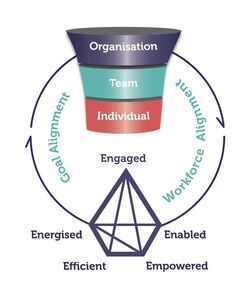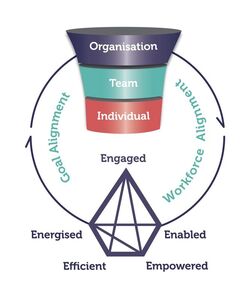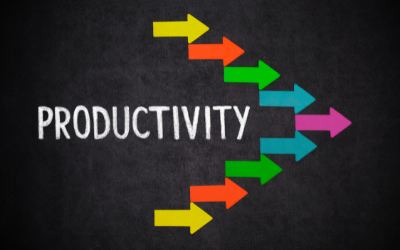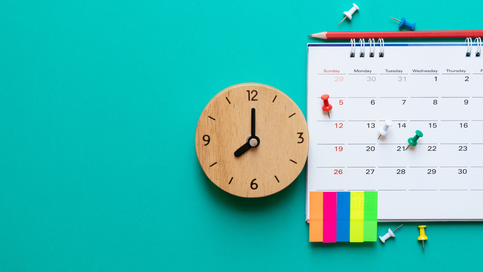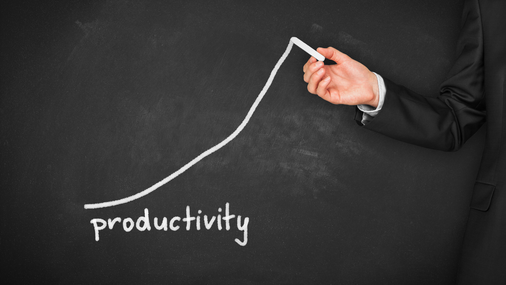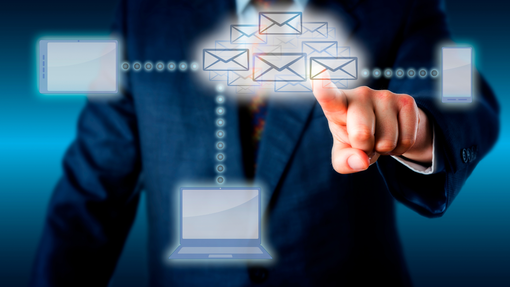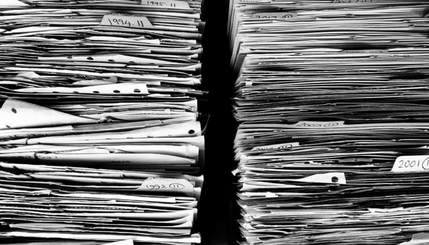|
Workforce effectiveness is a key performance indicator that measures the utilisation, performance, and wellbeing of the workforce. Collagis believe developing thriving individuals and teams is the best way to optimise workforce effectiveness. Our approach is summarised by “The Collagis Diamond Principle” and focuses on optimising 5 key elements which underpin effective workforces. The 5 key elements: 1. Engaged: Are our teams inspired by the vision, and motivated to act? 2. Energised: Can our people sustain the energy they need for high performance? Are they resilient? Thriving? 3. Efficient: Do our ways of working create the environment for maximum productivity? 4. Enabled: Do our processes, tools and capability support our teams to embed change and achieve goals? 5. Empowered: Is my organisation’s structure and programs well defined, adequately resourced and well-managed to deliver to the business objective?
Utilising this framework, Collagis seeks to deliver customised programs to improve workforce effectiveness. We'd love to share with you how we can help you to improve workforce effectiveness in your organisation.
Read Also: Optimising Organisational Effectiveness What is Organisational Effectiveness? Organisational effectiveness as a concept measures the degree to which an organisation achieves it's goals from Profit through to Service Quality and Productivity, all the way through to Customer Experience. There are many factors influencing organisational effectiveness such as:
The Importance of Organisational Effectiveness: By increasing your organisational effectiveness, a business can drive growth through:
To optimise organisational effectiveness an analysis of your business functions needs to be a priority to determine what efficiencies can be gained. Clear achievable objectives and goals can then be set to formulate a strategy that will address your priority areas to help improve your overall organisation effectiveness. An approach to Organisational Effectiveness by Collagis. The Collagis approach addresses organisational effectiveness holistically across five key dimensions at the individual, team and organisational level. It is through this holistic approach and five key dimensions that Collagis can enable individuals and teams to reach their peak performance and in turn deliver improved workforce and organisational effectiveness. The five key dimensions include: People Focused:
Utilising this framework, Collagis seeks to deliver customised programs to improve workforce effectiveness. We'd love to share with you how we can help you to improve workforce effectiveness in your organisation. Read next: How to optimise workforce effectiveness Tip 6. Begin on time.
Show that each attendee’s time is valued and respected by starting each meeting precisely on time. Time wasted, waiting for a meeting to start is very annoying, unprofessional and unproductive. Late beginnings to meetings lead to late finishes which can cause further problems later in the day. Tip 7. Use prep work. As a time saving strategy, distribute any appropriate documents either for people to prepare or to work on prior to the meeting. Be sure to use it during the meeting so participants will feel their preparation time was well spent. Tip 8. Stay on schedule. Meetings that are overtime make it difficult for participants to maintain their focus. Being side tracked and going off on tangents can cause meetings to draw out and become unproductive. When discussions deviate from the agenda, get back on track by refocusing the group on what matters. Not sticking to the time schedule of a meeting can throw out the participants calendar as well for the rest of the day and cause frustration and stress leading to a decline in productivity. Tip 9. Keep a record. It’s important to maintain a good record of what happens during each meeting to help keep a track of important decisions. Minutes are a tangible record of the meeting for its participants and a source of information for members who were unable to attend. Minutes can also serve to notify or remind individuals of tasks assigned to them and/or timelines. Tip 10. Assign action items. Effective meetings rely on well-executed action items. Identify actions items that will need follow-up, determine who will be responsible for the item and set completion dates. Collagis is committed to helping businesses like yours to optimise workforce and organisational effectiveness. We'd love to share with you how we can help you increase your productivity. Meetings have a bad rap for being a waste of time. Meetings can be plagued with inefficient, unproductive processes such as:
Ineffective meetings can zap morale and can be very costly if we calculate the amount of time and personnel that participate in them. Effective meetings don’t just happen. However, with the right planning, practice and time management, they can become a productivity tool for your team. Following are tips for running effective meetings that will increase productivity and stop wasting time. Tip 1. Have a clear purpose in mind. Productive meetings have a clear goal and purpose that can be easily identified and summed up in a couple of sentences. Making an assessment of the worth of the meeting and what you hope to achieve from the meeting is crucial. Crammed meetings can be a real drain on time and energy and eliminating any unnecessary items can be very productive. Committing to focus only on what clearly matters can more effectively accomplish your goals. If you are requesting people to devote time for the meeting then it should be for a good reason and productive. Tip 2. Always have an agenda. Your agenda should set out a clear strategic roadmap for your meeting by indicating goals, creating a structure for the meeting and incorporating action steps. The agenda will help to keep the meeting moving forward by sticking to agenda items that are pre-organised and relate to the topic and your purposes. It is an effective strategy to distribute the agenda at least a day in advance so participants have had a chance to review it beforehand and have had time to think about the items. This can often yield more productive discussions. Tip 3. Keep it short. Keeping meetings to less than one hour and limiting the number of items included can increase efficiency. When planning your agenda, estimate the amount of time needed for each discussion topic so you can attempt to keep your meeting under one hour. If it appears that you don’t have enough time for all items determine if there are items that could be handled by individuals instead of the whole group. Determining the priority and need for each agenda item can be effective in keeping the meeting under one hour. Tip 4. Reduce travel time. If your business is spread out across numerous locations the time spent commuting to a meeting is very unproductive. A more time productive option would be to hold the meeting online through a platform such as Zoom. Tip 5. Eliminate possible distractions. Laptops, tablets and smartphones can be essential tools for conducting business but can zap meeting productivity. They can be a huge distraction that can cause users to tune out. Consequently, information may need to be repeated or addition time is spent clarifying items during discussion. This can contribute to the meeting running overtime and reduced productivity. Unless these tech tools are needed they should be switched off or not brought to the meeting. Collagis is committed to helping businesses like yours to optimise workforce and organisational effectiveness. We'd love to share with you how we can help you increase your overall productivity. Read Next: The 5 best tips to running effective meetings - Part 2 26 habits that can improve productivity 6 tips to reduce procrastination Productivity can be explained as the efficiency by which we convert inputs, such as capital, raw materials and labour, into output.
To increase personal productivity we need to grow our output faster than our inputs. Our inputs will therefore become more efficient and productive. There are two ways to increase our output. We can either work more hours or work smarter. I am confident that anyone would rather work smarter than longer. Making smart choices, by knowing and understanding best practice can help you to work more efficiently and improve productivity. Following are several ways in which you can improve your productivity. 1. Use a digital calendar Used effectively your calendar can empower you to plan your time to maximise productivity and enhance the efficient use of your daily program. Tips that can help you to achieve greater productivity are as follows:
2. Manage your emails efficiently If you’re inundated with emails, it is possible to gain control. You might want to rethink your methods for organising your emails and emptying your inbox. Developing ways to process your emails can enable you to gain greater control, improve your response time and keep up with important actions and due dates. Following are some specific strategies to help you manage your emails.
3. Habits that can Improve Productivity The habits we develop can have a significant impact on our productivity. Bad habits that interfere with our productivity can be a consequence of being reactive rather than proactive. Our goal should be to replace bad habits that are often caused by knee jerk reactive patterns with good habits that will make us proactive and enable us to take charge of our own agendas. Following are ways to form habits that increase work productivity.
Collagis is committed to helping businesses like yours to optimise workforce and organisational effectiveness. We'd love to share with you how we can help you improve your productivity. Procrastination is the action of unnecessarily postponing decisions or actions by delaying or putting off tasks. There may be several reasons for procrastinating including: disliking the tasks to be done, or finding the work too difficult or tedious, or perceiving that the work is not urgent and doesn’t need your immediate attention.
Procrastination can become a habit, one that can easily lead to difficulties in managing your workflow and time and effecting your productivity. We can become very competent at coming up with seemingly valid reasons for putting off tasks, but to increase productivity we need to shift our perspective and apply the same ingenuity for procrastinating, towards thinking of ways to complete tasks quickly and efficiently. Be as clever about completing things as you’ve been about putting them off. Reducing the habit of procrastination could be achieved by using some of the following ideas. 1.Do it NOW! When faced with a task that could be completed in less than fifteen minutes don’t think too much about whether there is some ideal time in the future where you can squeeze it in. Having this frame of mind can be the start for many procrastinators. Having a habit of putting things off only because they seem small, or unimportant, or can be done quickly can inevitably lead to the same task never getting done! Seemingly small, quick tasks can accumulate quickly, and can often end up weighing you down psychologically, distracting your attention from the more important tasks. Do the small tasks as quickly as possible. Completing them immediately, will enable you to never have to get back to them again! Your calendar will be freed up allowing you to focus on more important or time consuming work. Don’t wait for the perfect moment, take the moment now and make it perfect. 2.Chunking Larger projects can be broken into smaller, bite-sized actions. This will make the task seem less overwhelming and much more doable. It’s a lot easier to get started on a project when you establish simple, reachable goals. This method can be especially beneficial for those who are intimidated when presented with tasks that appear to be too tedious or time consuming. Accomplishing multiple tasks rather than just one can also give you the sense of achieving more, help you stay driven throughout and give your enthusiasm a boost. 3. Focus On the Outcome The size of a reward or the promise of high returns can sometimes determine the worth of doing a task and your motivation to begin them. In some circumstances by not doing something could result in highly negative consequences such as not paying a bill on time. If you find yourself procrastinating on tasks that have potentially big ramifications focus on what will happen if you do or don’t do something by a certain time. Focus on the best outcome you could achieve and work towards accomplishing that ideal outcome. Chances are, you will feel motivated to start working. 4. Celebrate Milestones Everyone loves being rewarded. It’s important to give yourself incentives, no matter how small. For large projects, celebrate each milestone completed by rewarding yourself. Celebrating the smaller milestones after the completion of key stages is a form of positive reinforcement, which helps to solidify a sense of progress and achievement that can help motivate you in starting the next phase of the project. This will also sustain you psychologically and support your drive to see your project or task to its successful end! 5. Do the Worst First Faced with a list of time consuming difficult tasks, you may procrastinate over where and when to start. Tackling the hardest task can actually be a good place to begin. Starting with the hardest task when you are at your best and are working at your optimum level will make it easier and more efficient to complete. Clearing and completing the hardest, most time-consuming task will also help to boost your morale and free up your time for the other things on your list. 6. Find a Buddy If you work in a team situation or have a close relationship with your colleagues, they could be the key to overcoming procrastination. They could help you monitor your work management by sharing your goals and task list. Let them know your timeline for completing certain tasks so that can monitor and track your progress. Hold each other accountable by reporting your progress at regular intervals. The person you choose should be someone you respect enough to listen to and they should be strong enough to reprimand you if needed. Being accountable to a trusted colleague may be enough to spur you into starting and completing the tasks. Procrastination is a challenge most people struggle with some time or other. However, tackling procrastination doesn’t need to be unsurmountable. By identifying your habits that lead to procrastination, you may choose to use some of these ideas to help you be more decisive and reduce the occurrence of procrastination and increase your productivity. Collagis is committed to helping businesses like yours to optimise workforce and organisational effectiveness. We'd love to share with you how we can help you increase your productivity. Making full use of your calendar can’t generate extra hours in the day but it can certainly save you time by raising your efficiency and productivity.
Millions of people every day use a program to manage their emails and calendar at work. Unfortunately, few of us really know how to make full use of all the features and benefits in these programs! Moreover, we can often become reactive, allowing others to schedule and plan our time, rather than taking control of our calendar to ensure we are spending our time on the things that matter most to our strategic objectives. Used effectively, your calendar can empower you to plan your time more effectively and maximise productivity. Outlined below are 6 tips for using your calendar to maximise productivity: Tip 1 – Map out your week in advance. Planning your week in advance on the previous Friday is a great habit to get into. Prioritise tasks for the week and add them to your calendar first. Select 1-3 of the most important tasks per day, then block out time for those tasks. Then, fit the less important tasks around your schedule. Scheduling your most critical tasks at the most productive time of the day is also a good idea. Tip 2 – Start each day with your calendar. Once your calendar is set up for the week, start each day reviewing it, so you know what’s coming up. Be ruthless with your time to consider what meetings you can delegate, which you can shorten (could it be done in 15 mins), which could be shared via a more agile communication method, and which can be cancelled. Beware particularly of recurring meetings and meetings without an agenda. If there is not a clear goal for the meeting, it is likely not worth having. Pre-reading is also a useful time saver. Having a chance to review a pack ahead of the call, can help you focus the call on decisions to be made, rather than background context and slides. Finally, consider the invitees, who is a must have versus a nice to have? How can we make more time for attendees to do proactive work, through having less people in meetings. Tip 3 – Use time-blocking. Dividing your day into blocks and then assigning tasks to each block, is an efficient strategy towards improving productivity. Any task that takes more than 15 minutes should be allocated its own time block. Time-blocking helps you to proactively prioritise your tasks and focus on one task at a time. Having deadlines, through time-blocking will also make it more likely that you will finish tasks. Tip 4 – Leave a buffer between meetings. A productive strategy can be to set aside 15 minutes after each meeting for review. While the meeting is still fresh in your mind, you can quickly make notes or schedule work that came out of it. It also allows a buffer for unforeseen events or a miscalculation of required time for that task. Tip 5 – Try colour coding. Colour coding is an effective way to manage your calendar. By grouping similar tasks by colour, you can quickly view your calendar and make sure that it aligns with your goals. Tip 6 – Time for rest. Be proactive and schedule rest time in your calendar. Including a buffer between work provides time to rest and recharge which has been proven to improve productivity. A calendar is more than a tool to schedule your time-based commitments. It is a productivity roadmap. It helps you create a routine so every day can be a productive day. Collagis is committed to helping businesses like yours to optimise workforce and organisational effectiveness. We'd love to share with you how we can help you achieve your goals more efficiently. The Personal Efficiency Program (PEP) helps individuals and teams to improve personal productivity and gain back on average 2 hours per person per day for meaningful work. Ask us for more information about how this could help your organisation to thrive. Emails, reports, subscriptions, market research, newspapers, books, and brochures are just some of the information sources that we are inundated with, in our modern workplaces. Like it or not, we are caught up in an age where there is an explosion of information. With this constant bombardment of information it has become more and more difficult to manage efficiently the information we receive. It is only natural to sometimes suffer from information anxiety and a sense of being overwhelmed. It has become crucial to have systems in place to be able to organise this information efficiently so we can find it easily. Following are four strategies that will help you keep your information organised. Strategy 1 - Have a place for everything and everything in its place An analogy can be made with your kitchen. There is a place for your cutlery, plates, utensils, etc that enables you to find them quickly. This is also desirable in your workplace. You want all incoming work/information in a specific home so you know where to find it and are able to retrieve it efficiently when you need it. Strategy 2 - Have the most frequently used items closest at hand Items that you use frequently should be stored in an easily accessible place, close at hand. Items that you would rarely use could be stored for instance, in a cabinet across the room. Strategy 3 - Keep like items together Organise similar information by bunching them together in a way that makes sense to your brain so it can be efficiently retrieved. Strategy 4 - Only keep what you need. Make an assessment of the value of the information when you receive it. Determine if you have used this type of information before, if the answer is not often, then just get rid of it. The trick is to be lean, because the leaner you are the more efficient you are likely to be. Over time we can develop certain ‘habits’ which sabotage our efficiency. Assessing systems we have in place and adjusting them if needed is a positive step towards greater productivity. Collagis is committed to helping businesses like yours to optimise workforce and organisational effectiveness. We'd love to share with you how we can help you to organise information more efficiently. The Personal Efficiency Program (PEP) helps individuals and teams to improve personal productivity and gain back on average 2 hours per person per day for meaningful work. Ask us for more information about how this could help your organisation to thrive. With the impact of Covid19 on our workplace, the percentage of people remote working from home has skyrocketed. Working from home has its own unique challenges but if your goal is to increase productivity, it is important for you to understand how crucial the role habits can play.
The habits we develop can have a significant impact on our productivity. Our goal should be to replace bad habits that are often caused by reactive patterns of behaviour with good habits that will make us proactive and enable us to take charge of our own agendas. While we are experiencing workplace changes, it is an opportune time for us to review our work habits to change any unproductive habits and build new more productive ones. The following are 12 ways to form habits that increase work productivity. Habit 1 - Start each day with a plan. Having a plan can drastically increase your work productivity. A plan can enable you to focus on what’s important instead of getting distracted by unforeseen tasks that inevitably pop up. It is a good habit to create a plan during the afternoon for the following day. Select any essential tasks that are crucial for you to finish by the end of the day and then block out times in your calendar to complete them. For the most important work it is suggested that you use the most productive times of the day when you are most efficient. Remember, if you fail to plan then you plan to fail. Habit 2 - Try to minimise distractions Minimising unwanted distractions will help keep you on task and increase productivity. Wearing headphones when there are noise distractions or reducing visual distractions such as pop-ups on your computer screens are just a couple of simple ways to increase productivity. Habit 3 - Concentrate on one thing at a time Single tasking is one key action towards improving productivity. Research has shown that multitasking can negatively influence your productivity. You may think that by multitasking you will get more done, but when you jump between tasks, your cognitive processing is hindered and you are less productive. By focussing on a single task enables you to get into a deeper state of mental concentration and achieve your most efficient results. Working deeply can take a lot of energy and effort so it’s important that you take breaks. The Pomodoro Technique provides a useful guideline when working intensely. Work 25 minutes of focused work, followed by a 5-minute break. Habit 4 - Start your day early Early in the morning is a time when it has been shown that your creativity and willpower is strongest. Coupled with this is the time of day when you feel fresh and energised. By starting early you can also reduce the number of interruptions you may get as emails, phone calls and personal interruptions become more frequent during the day. Habit 5 - Time-blocking works wonders Time blocking is an excellent way to organise your time more efficiently by assigning tasks to time blocks that you have divided the day into. By time blocking you can be proactive by prioritising your most important tasks and focus on one task at a time increasing proactivity. Habit 6 - Close your inbox Email is one of those 21st Century tools that you could not do without but it can also be one of your biggest distractions. By time blocking specific times to check and reply to messages and having your inbox closed and out of sight for the rest of the day can be a significant habit that will lead to greater productivity. Habit 7 - Take small steps A huge project can often feel daunting and we begin procrastinating over it. We find other tasks such as cleaning out our desk or redesigning our work space to put it off. A more effective approach is to break the project into smaller achievable steps that forms a list of tasks that are much more manageable and motivational. Habit 8 - Reward yourself Create a positive mental cycle by rewarding yourself for completing work and doing a job well done. When you finish a task, reward yourself and this will make you feel more inclined and motivated to begin the next task. For mental health, the habits of treating yourself when you reach milestones and celebrating success will have a positive effect on future productivity. Habit 9 - Eat smart The World Health Organisation has estimated that eating the right food can boost our brain power by up to 20%. An important habit to increase productivity is to eat healthily and regularly. Choosing nutritious foods and avoiding sugary snacks that make you crash will help you work at your best. Skipping meals can make you tired, irritable and mentally fatigued negatively affecting your productivity. Habit 10 - Exercise regularly A healthy habit such as regular cardiovascular exercise can be a crucial factor in working productivity. Exercise can boost your memory, attention span, creativity and can also lower stress and improve mood - a plethora of positive outcomes to increase your productivity. Habit 11 - Use productivity apps If you want to be the best you can you need to take advantage of the best, most efficient tools that are available to you. There are many apps that are available to boost your productivity and you should be building your arsenal of technology to give you the edge in a very competitive market. A great example of this is Microsoft To Do. This app syncs between your mobile and desktop to help you keep on top of your to-do lists and organise tasks by stream and deadline. Habit 12 - Delegate wisely Taking the burden and workload of too many tasks can be anti-productive. If you are trying to carry too much weight on your shoulders you likely to crash and burn but by delegating wisely you can share this load. If there is someone else who is better suited to a job then delegate it. Smart delegation of jobs when needed helps you achieve your goals without sacrificing productivity. By developing good habits you can build a productive workplace to help you work to your potential. Collagis is committed to helping businesses like yours to optimise workforce and organisational effectiveness. We'd love to share with you how we can help you to improve productivity. The Personal Efficiency Program (PEP) helps individuals and teams to improve personal productivity and gain back on average 2 hours per person per day for meaningful work. Ask us for more information about how this could help your organisation to thrive. Is your email inbox out of control?
The endless barrage of emails can be one of the consistently stressful tasks of the workplace. When you get hundreds of emails each day there is bound to be productivity loss. The ramifications of an overflowing inbox go beyond increased stress, it can affect your efficiency and inevitably your productivity. If you’re inundated with emails, it is possible to gain control. You might want to rethink your methods for organising your emails and emptying your inbox. Developing ways to process your emails can enable you to gain greater control, improve your response time and keep up with important actions and due dates. Following are some specific strategies to help you manage your emails that follow the Personal Efficiency Program approach. Strategy 1 - Do It Now It is better to handle each email only once before you take action. You should decide what to do with it and where to put. Using the 4Ds model can be an effective strategy: 1. Delete it 2. Do it 3. Delegate it 4. Defer it Strategy 2 - Process one item at a time, starting at the top Set a plan of attack. Sort your emails by order in which you will process them. For example, you could filter by date, subject, sender or receiver. Resist the temptation to jump around in your Inbox in no particular order. Start processing your first email and only move to the second one after you’ve dealt with the first. Don’t procrastinate on emails and your efficiency in dealing with them will improve. Strategy 3 - Organise your email inbox with labels, folders and/or categories. Your email folders should mirror your paper working files. An effective filing system will make it easier to locate emails efficiently when you need them. Strategy 4 - Turn off sound and message notifications Set aside blocks of time in your calendar, a few times a day to respond to your emails. This minimises the distraction of incoming emails as well as giving you a systematic approach to reading emails. Strategy 5 - Make sure your email clearly reflects its content Clearly identify the content of the email by using a succinct subject line that clearly explains the content that will follow. This will allow greater efficiency in locating emails in the future. Strategy 6 - Send messages or replies only to recipients who need the information Understanding the correct distinction between the “To:” field and the “Cc:” field can significantly reduce time when dealing with emails. The “Cc:” field is only for those who are being copied so they are kept in the loop. If you are “Cc’d”, remember that the email is for your information only and you are not required to respond. Strategy 7 - Reduce the number of emails being received Unsubscribe from any mailing lists that aren’t appropriate. Unnecessary email groups should also be avoided and use a filter to prevent unsolicited emails. Encourage team members to use Cc sparingly to avoid noise and distraction unless you are necessary to be across it. If a conversation is required, leveraging a phone call, face to face or chat message may be a more efficient mechanism to efficiently deal with the issue, so opt for those channels rather than email where required. By developing efficient ways to process your emails you will be able to gain greater control of them, improve your response time and keep up with important actions and due dates. Collagis is committed to helping businesses like yours to optimise workforce and organisational effectiveness. We'd love to share with you how we can help you to boost productivity. The Personal Efficiency Program (PEP) helps individuals and teams to improve personal productivity and gain back on average 2 hours per person per day for meaningful work. Ask us for more information about how this could help your organisation to thrive. In August 2020, Collagis undertook a survey of current Executive Assistants and Executive Officers within the Australian market. The survey was conducted to understand the role of the Executive Assistant (EA) and Executive Officer (EO) across industry in Australia.
Following are 6 key insights into Executive Assistant roles that have been gleaned from the results. Job Satisfaction Insights Job satisfaction was positive across the range of those surveyed. All parameters surveyed indicated that over 70% were somewhat satisfied or very satisfied. The highest degree of satisfaction was about their own level of effectiveness followed by their salary and a positive attitude towards their organisation. On the contrary, job dissatisfaction, where it occurred, was under 5% and was linked to two primary causes: dissatisfaction with the Executive supported and dissatisfaction with the level of ongoing training received. The level of satisfaction is supported by the extended tenure of those currently in the EA role, typically greater than 10 years. Also, the level of tenure significantly exceeds other mainstream roles in both the Public and Private sectors. Pay Insights Executive Assistant’s in the Private sector have an average base salary of $91k which represents a 5% premium over their peers in the Public sector at $87k. Executive Assistants in the Public sector in capital city metro locations have an average salary of $87k versus their regional counterparts’ average salary of $83k, a 4.3% premium. An incentive component was added to base salary for just over half of survey respondents. Role Type Insights The level of Executive supported, where “Level” is the number of organisational hierarchy steps from the most senior person in the organisation, it was noted that on average an Executive Assistant primarily supports levels 0 to 3. Training & Career Insights More than half of the sample surveyed are career EA’s (i.e., more than 10 years’ service in role). A significant percentage are degree qualified including some with post-graduate degrees. More than 90% of EA’s have no formal EA-specific training. Furthermore, a similar percentage of the Executives they support have no formal training in how to best utilize the EA’s that support them. Support Model insights The models observed and explored included the following:
Work Duties Insights Work duties varied by role type, industry and organisation, with the most common responsibilities pertaining to Executive Calendar Management, Administration, Meetings and Management of Executive Physical office space. Staff management was uncommon in role respondents. This blog has only touched the surface of the insights gained from this survey and the data collected. For a more comprehensive analysis and insight into understanding the role of the Executive Assistant (EA) and Executive Officer (EO) across industry in Australia, you will need to download the entire report from this site. The Challenge. Do you find yourself wasting time looking for things at work? Whether it’s paper or electronic files the frustration that comes with not being able to find that document or file is stressful and can reduce effective output.
The Cost. In short, the cost of not being able to place your hands on that item of work you need is time. Some people we work with waste up to an hour a day trying to find things. What could you do with an hour of time back in your work day? Simple tips to help you find things in rapid speed
Whatever approach you use make sure that it’s serving you and not the other way around! Want to know more about how you can improve your productivity in the workplace? Contact us at [email protected] OR visit collagis.com.au/pep to find productivity programs for your workplace. We'd love to hear from you. [1] https://hbr.org/2012/01/tip-for-getting-more-organized.html [2] https://www.whatsbestnext.com/2008/12/filing-vs-piling/ [3] https://www.mindtools.com/pages/article/newHTE_85.htm By Andrew Gallaway
The Challenge. What do you feel when you're in the zone - reading, writing, thinking - at work? Fulfilled, purposeful, in control? How do you feel when someone interrupts you in the zone? Frustrated, important, stressed, willing to please? Mixed feelings right? That's probably because there are 'good' interruptions and 'wasteful' interruptions. The good interruptions are when you're being informed of something that's urgent and important. The 'whoop, whoop' of the alarm is a great interruption if the building is on fire! But the wasteful interruptions can be damaging to an organisation because everyone loses - the interrupter and the interrupted. Neither is doing productive important work during the wasteful interruption. The Cost. Three interruptions per hour can cost you up to 30 minutes of time when you consider how long it takes to deal with the interruption and then get your mind back into work.[1] 5 Simple Tips to find your zone during work time 1. If someone comes into your workspace and interrupts you it’s likely that they consider the issue important; they might even be super pumped and excited. But how important and urgent is it compared to what you’re doing right now. The first step is to assess the nature of the interruption. “How can I help you?” If the matter is more urgent, drop what you’re doing and deal with it. If it isn’t, then could you make a later time that day to talk? 2. Consider saving up those important but not urgent conversations for another time. Collect your thoughts, emails, issues in a folder and take them to a 1:1 meeting with a colleague or a group meeting where the session is planned. It could be once or more per week. Cover off the matters you and your colleague have saved up during that session. You'll be amazed at how much time you save by batching those discussions. 3. Recognise if there’s a problem with interruptions in your workplace. This is important because interruptions can happen quite unconsciously and can become an organisational habit. So, awareness is the first step. 4. Talk to each other! If there’s a problem with interruptions talk to the team and get buy-in to recognise the costs. 5. Find the right place to work. At Collagis we believe that work needs to be done in the right workspace. If you have to do work where you need to concentrate and not be disturbed, could you book a meeting room to work in for an hour or so? Tell someone where you are going just in case and ask not to be disturbed unless it's an emergency. You'll only be gone an hour or so! Finding the right environment during work hours is kind of like coming into work early or staying late because that's the only way you can get work done; no one else is around to bother you. Think about it! Why are you doing that? Work in work hours as much as you can by creating the right conditions for you to get the work done. Want to know more about how you can improve your productivity in the workplace? Contact us at [email protected] OR visit collagis.com.au/pep to find productivity programs for your workplace. We'd love to hear from you. [1] https://www.forbes.com/sites/markmurphy/2016/10/30/interruptions-at-work-are-killing-your-productivity/#4fa3968f1689 Author: Andrew Gallaway
The Challenge: Do you find some people a joy to work with and others...well, not so? It could be that you have unrecognised preferences in the way each of you work. The Cost: When work preferences are at odds it can lead to frustration, stress, wasted time and in the worst case conflict at work. This situation is no way for a team to progress and be effective. 6 simple tips to discover and embrace work preferences
Want help to implement your work preferences review? Speak to Collagis today about how you can make a real difference to your team's effectiveness today. Contact us at [email protected] or visit www.collagis.com.au/pep to find productivity programs for your workplace. We'd love to hear from you. |
CUSTOMER SUPPORT |
FOLLOW US |
COLLAGIS PTY LTDLevel 9, Nishi
2 Phillip Law St NewActon ACT 2601 PO Box 40 Oyster Bay NSW 2225 Tel: +61 2 6243 3635 |
Copyright © Collagis 2015
All Rights Reserved
All Rights Reserved

